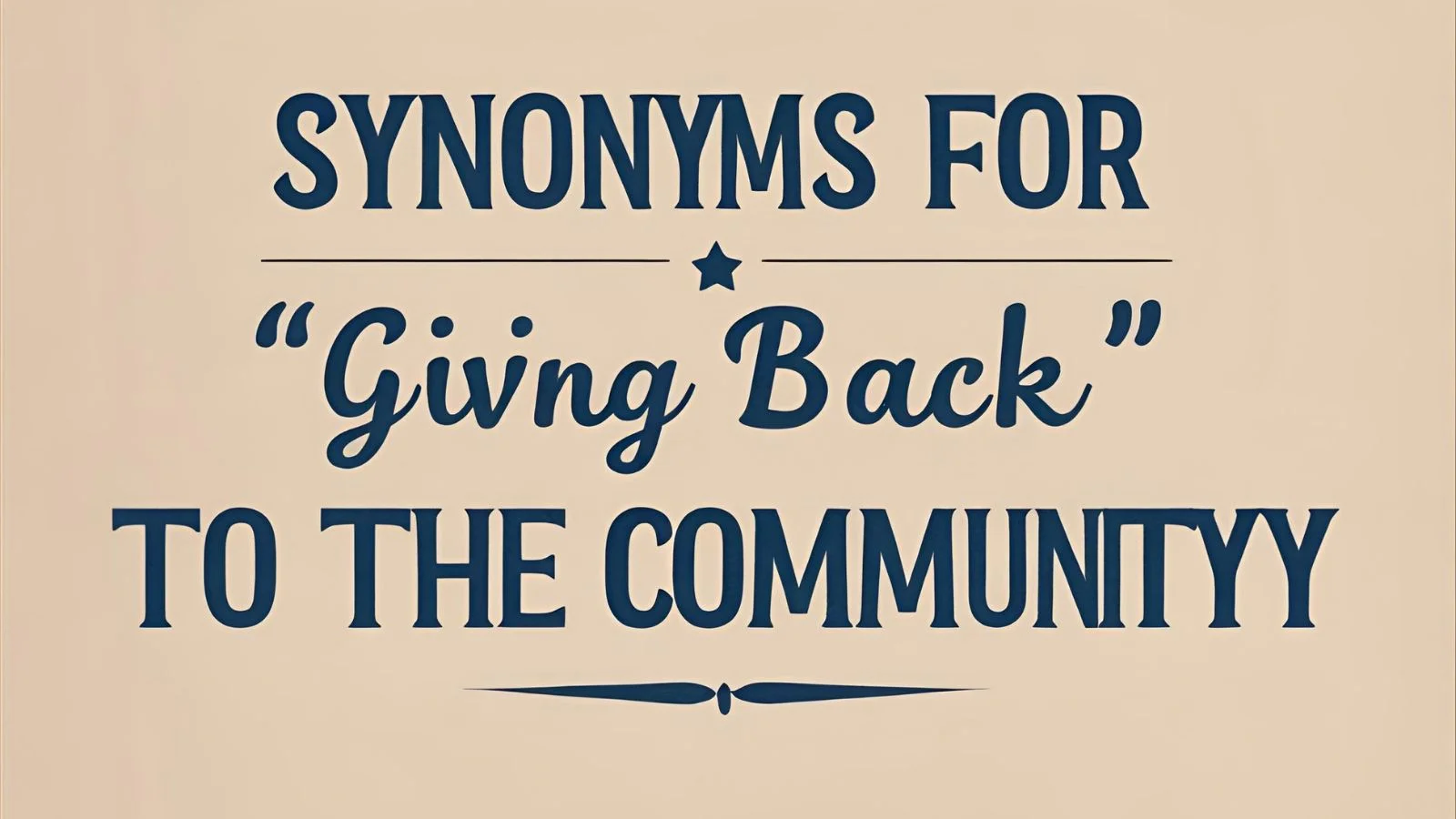Giving back to the community is a noble act that fosters kindness, unity, and social responsibility. Whether through volunteering, donating, or supporting local causes, helping others creates a positive impact. However, the phrase “giving back to the community” can sometimes feel repetitive. Using synonyms allows for variety in speech and writing while maintaining the core message of generosity and goodwill. Synonyms for “Giving Back to the Community”.
In this article, we will explore 15 alternative ways to express the concept of giving back. These phrases will help convey the same spirit of selflessness and service while making your message more engaging and dynamic.
Whether you are writing an essay, creating a speech, or crafting social media posts, these synonyms will help you articulate your commitment to community support. Let’s dive into meaningful expressions that highlight the essence of generosity and giving.
Contributing to Society
Supporting those in need and uplifting the community is at the heart of contributing to society. This phrase reflects the idea of actively engaging in efforts that enhance social well-being. From mentoring youth to funding educational programs, contributing to society encompasses all acts of kindness that strengthen neighborhoods and bring positive change.
People contribute to society in various ways, such as organizing charity events, sponsoring scholarships, and advocating for underprivileged groups. Businesses also play a role by implementing corporate social responsibility initiatives, such as reducing environmental impact or supporting local enterprises.
Contributing to society is not just about financial donations it involves time, effort, and creativity in making a difference. A simple act, like helping a neighbor or volunteering at a shelter, contributes to the greater good. When individuals and organizations commit to giving, society flourishes with compassion and unity.
Read More: Synonyms for “Nice-to-Have”
Supporting Local Initiatives
Communities thrive when individuals support local initiatives aimed at fostering growth, development, and well-being. This phrase encompasses efforts like sponsoring small businesses, attending charity drives, and volunteering in neighborhood projects.
Supporting local initiatives can involve donating to food banks, assisting in literacy programs, or participating in clean-up campaigns. These actions directly benefit local communities by addressing pressing issues and improving quality of life. People often overlook the power of small contributions, but even minor efforts can have a lasting impact.
By advocating for local causes, individuals create a ripple effect of generosity that strengthens community ties. Whether through financial support or active participation, backing grassroots efforts helps sustain programs that nurture a better future. Encouraging others to get involved fosters a collective spirit of responsibility and generosity.
Engaging in Philanthropy
Philanthropy goes beyond charitable giving it represents a deep commitment to addressing societal challenges through financial, social, or intellectual contributions. Engaging in philanthropy can involve funding scholarships, supporting healthcare initiatives, or investing in sustainable development projects.
Unlike one-time donations, philanthropy often involves long-term strategic giving. Wealthy individuals, corporations, and foundations use philanthropy to drive systemic change in areas such as education, poverty alleviation, and environmental conservation. However, one doesn’t have to be wealthy to engage in philanthropy. Anyone can contribute through consistent acts of generosity, such as funding local shelters or supporting community programs.
By engaging in philanthropy, people create opportunities for underprivileged communities and foster a culture of giving. Whether through monetary donations, mentorship, or advocacy, philanthropy fuels meaningful change and strengthens the fabric of society.
Volunteering for a Cause
Volunteering for a cause is one of the most direct and impactful ways to support a community. Giving time, skills, and energy to assist those in need fosters strong relationships and brings about positive social change. Whether tutoring students, assisting at food shelters, or participating in environmental conservation efforts, volunteering bridges the gap between need and support.
Organizations rely on volunteers to expand their reach and effectiveness. Nonprofits, shelters, and medical missions depend on the dedication of individuals who are passionate about making a difference. Volunteering not only benefits communities but also enriches the lives of those who give their time.
Many people find fulfillment in volunteer work, as it provides opportunities to learn, grow, and build meaningful connections. By stepping up to help, individuals become part of a greater movement that values compassion, service, and shared responsibility.
Promoting Social Responsibility
Promoting social responsibility means fostering awareness and encouraging ethical practices that benefit society as a whole. This phrase reflects the importance of ensuring that individuals and organizations operate with integrity, fairness, and accountability.
People can promote social responsibility by supporting ethical businesses, reducing waste, or advocating for human rights. Companies also embrace this concept through sustainable practices, employee welfare programs, and community engagement.
When social responsibility is prioritized, communities experience positive change. Consumers influence industries by choosing brands that align with ethical values. Meanwhile, individuals drive change by holding institutions accountable and championing causes that matter. By adopting socially responsible habits, people contribute to a more just and compassionate world.
Investing in Community Growth
Investing in community growth goes beyond financial contributions it includes providing resources, knowledge, and mentorship to help neighborhoods thrive. This phrase highlights the importance of long-term commitment to improving the quality of life for all residents.
Businesses invest in community growth by funding infrastructure projects, supporting local entrepreneurs, and creating job opportunities. Educational programs, health initiatives, and economic development efforts also contribute to sustainable progress.
Individuals, too, can invest in their communities by volunteering in schools, mentoring youth, or supporting public service projects. Every effort, big or small, adds to a community’s overall prosperity. Investing in community growth fosters a culture of shared success and resilience.
Strengthening Civic Engagement
Civic engagement is about active participation in the political, social, and economic aspects of a community. Strengthening civic engagement means encouraging individuals to take part in decision-making processes and initiatives that impact society.
People can strengthen civic engagement by voting, joining advocacy groups, and supporting policies that promote equity and justice. By staying informed about local issues and participating in community discussions, individuals contribute to meaningful change.
Governments, nonprofits, and educational institutions play a role in fostering civic engagement by providing platforms for dialogue and action. When communities are actively involved, they become more empowered to address challenges and drive progress. Civic engagement strengthens democracy, amplifies voices, and ensures that every individual has a stake in shaping the future.
Championing Charitable Efforts
Championing charitable efforts means taking an active role in supporting causes that uplift those in need. Whether through fundraising, event planning, or spreading awareness, individuals can drive meaningful change by advocating for charities and nonprofits.
People champion charitable efforts by organizing food drives, donating clothes, or raising money for medical research. Social media has made it easier than ever to spread awareness about global issues and encourage others to contribute. Even small gestures, like sharing a charity’s mission, can make a big difference.
Businesses also take part by donating a percentage of their profits to social causes or establishing corporate philanthropy programs. By championing charitable efforts, communities come together to address societal challenges and create opportunities for those in need. The more people get involved, the greater the impact, making generosity a powerful force for good.
Encouraging Acts of Kindness
Encouraging acts of kindness helps foster a culture of compassion and generosity. Small, everyday actions such as helping a neighbor, paying for someone’s meal, or writing a note of appreciation can brighten lives and strengthen communities.
Kindness is contagious. When one person shows generosity, it inspires others to do the same. Schools, workplaces, and social groups can encourage acts of kindness by initiating community projects, appreciation programs, or volunteer activities. Even digital spaces can be used to spread positivity by highlighting good deeds and motivating others to take action.
Encouraging acts of kindness doesn’t always require money offering time, a listening ear, or words of encouragement can have a lasting impact. In a world that often feels busy and chaotic, kindness reminds us that human connection is essential. The more we uplift one another, the stronger and more unified our communities become.
Empowering Underserved Communities
Empowering underserved communities means providing opportunities, resources, and support to those who need them most. Many communities face challenges related to education, employment, and access to basic needs. Addressing these issues helps bridge gaps and create pathways for success.
One way to empower underserved communities is through education and mentorship programs. Teaching valuable skills, offering scholarships, or providing career guidance helps individuals break cycles of poverty and create better futures. Businesses and nonprofits can also contribute by investing in infrastructure, healthcare, and economic development initiatives.
Advocacy plays a key role in empowerment. By amplifying the voices of marginalized groups, individuals and organizations can push for policies that promote equality and access to resources. When communities are given the tools to succeed, they gain the confidence and ability to shape their own futures. Empowering others creates long-term, sustainable change that benefits society as a whole.
Advocating for Social Change
Advocating for social change involves taking a stand on important issues and pushing for policies that improve society. This can include fighting for human rights, environmental protection, racial equality, or economic fairness.
Individuals can advocate for social change by attending protests, signing petitions, or using their platforms to spread awareness. Education is a powerful tool learning about issues and sharing knowledge with others fosters a more informed and engaged society.
Nonprofits, activists, and community leaders work together to address systemic issues and drive progress. Many successful social movements have started with passionate individuals who refused to accept injustice. Even small efforts, like contacting representatives or supporting ethical businesses, contribute to a broader movement for change.
Advocating for social change requires persistence, but it has the power to reshape societies for the better. By taking action, people help build a more just, equitable, and compassionate world.
Fostering a Spirit of Generosity
Fostering a spirit of generosity means creating an environment where giving is valued and encouraged. Whether in families, schools, or workplaces, promoting a culture of selflessness inspires people to contribute to the well-being of others.
Teaching generosity starts at a young age. Parents can instill this value by encouraging children to share, help others, and express gratitude. Schools can introduce community service projects that give students hands-on experience in making a difference.
In professional settings, companies can foster generosity through charitable programs, donation matching, or paid volunteer days. When organizations prioritize giving, employees feel more connected to their communities and motivated to help others.
Generosity doesn’t always mean financial contributions it includes time, effort, and kindness. A spirit of generosity strengthens human connections and creates a more compassionate world. By making giving a part of everyday life, individuals and communities thrive together.
Inspiring Volunteerism
Inspiring volunteerism means motivating people to give their time and skills to help others. Volunteers play a crucial role in strengthening communities by supporting food banks, shelters, schools, and nonprofit organizations.
Encouraging volunteerism starts with leading by example. When people see others dedicating their time to meaningful causes, they feel inspired to do the same. Schools, workplaces, and community groups can organize volunteer events, making it easier for individuals to get involved.
Many organizations offer flexible ways to volunteer, such as virtual mentoring, skill-based contributions, or short-term projects. Even small acts of service, like cleaning up a park or helping a neighbor, contribute to a culture of generosity.
Volunteering benefits not only those receiving help but also those giving it. It fosters personal growth, builds connections, and creates a sense of purpose. By inspiring more people to volunteer, communities become stronger and more compassionate.
Supporting Grassroots Movements
Supporting grassroots movements helps drive change from the ground up. These movements are often started by passionate individuals or small groups working to address local issues, from environmental sustainability to social justice.
Grassroots efforts rely on community support to grow and create impact. People can contribute by attending local meetings, spreading awareness, or donating resources. Social media has made it easier to amplify messages and rally supporters, giving grassroots movements a wider reach.
Unlike large organizations, grassroots initiatives often operate with limited funding and resources. Every contribution whether financial support, volunteering, or simply spreading the word helps sustain their efforts. By empowering these movements, communities take ownership of their future and advocate for meaningful change.
Many historical and modern successes, such as civil rights advancements and environmental policies, began with grassroots activism. Supporting these initiatives ensures that voices at all levels of society are heard and that communities can work together to create lasting progress.
Building a Culture of Philanthropy
Building a culture of philanthropy means encouraging generosity on a larger scale. Philanthropy goes beyond individual giving it involves businesses, foundations, and communities coming together to support causes that improve society.
Organizations that promote philanthropy create opportunities for people to give in meaningful ways. Businesses can establish charitable foundations, match employee donations, or provide grants to nonprofit organizations. Schools and universities can foster philanthropy by involving students in fundraising and service-learning programs.
Philanthropy isn’t just about money it includes donating time, expertise, and resources. When people see generosity being valued and celebrated, they are more likely to contribute. Public recognition of charitable efforts also encourages others to participate, creating a ripple effect.
By embedding philanthropy into everyday life, communities become more connected and resilient. Whether through small personal donations or large-scale initiatives, cultivating a spirit of giving helps make the world a better place for future generations.
Promoting Sustainable Giving
Promoting sustainable giving ensures that charitable efforts have a lasting impact. Rather than short-term solutions, sustainable giving focuses on long-term change by addressing root causes and empowering communities.
Sustainable giving includes supporting organizations that provide education, healthcare, and job training rather than just temporary aid. For example, instead of donating food for a day, funding programs that teach farming or financial literacy helps people become self-sufficient.
Businesses can engage in sustainable giving by implementing ethical practices, such as fair wages and environmentally friendly policies. Consumers can support these efforts by purchasing from companies that reinvest in communities.
Partnerships between nonprofits, governments, and private sectors also strengthen sustainable giving. By working together, they create initiatives that provide long-term benefits rather than just immediate relief.
Sustainable giving transforms the way people help others. It shifts the focus from short-term charity to long-lasting empowerment, ensuring communities continue to thrive independently.
Strengthening Community Bonds Through Giving
Strengthening community bonds through giving fosters connection, trust, and support among people. When individuals come together to help one another, they build stronger, more united communities.
Community-driven giving includes neighborhood cleanups, local fundraising events, and mutual aid networks. These initiatives create opportunities for people to connect while addressing shared challenges. When people see their contributions making a direct impact, they feel more invested in their community’s well-being.
Shared giving also brings people from different backgrounds together, promoting inclusivity and understanding. Whether through faith-based groups, school programs, or workplace initiatives, giving unites people with a common purpose.
Beyond financial donations, strengthening community bonds involves offering time, mentorship, or emotional support. Small gestures, like checking on neighbors or supporting local businesses, reinforce the sense of belonging.
A strong community thrives on generosity and collaboration. When giving becomes a shared value, people create lasting relationships and a supportive environment where everyone benefits.
Encouraging Corporate Social Responsibility
Encouraging corporate social responsibility (CSR) means motivating businesses to give back to society in meaningful ways. Companies have the power to create positive change by supporting charitable causes, reducing environmental impact, and promoting fair labor practices.
CSR initiatives can include donation matching, employee volunteer programs, and sustainable business practices. Many companies partner with nonprofits to address global challenges such as poverty, education, and healthcare. By aligning their mission with social good, businesses strengthen their brand reputation while making a real difference.
Consumers are more likely to support brands that prioritize social responsibility. When businesses invest in ethical practices and community initiatives, they build trust and loyalty with their customers. Employees also feel more engaged when working for a company that values social impact.
Corporate social responsibility benefits both businesses and society. By promoting ethical and sustainable initiatives, companies contribute to a better world while fostering long-term success.
Investing in Future Generations
Investing in future generations means providing young people with the tools, knowledge, and opportunities they need to succeed. Whether through education, mentorship, or financial support, helping the next generation thrive leads to a stronger society.
Scholarships, tutoring programs, and youth mentorship initiatives empower children and teens to reach their full potential. Community organizations and nonprofits often provide resources such as school supplies, career guidance, and extracurricular programs to support learning and personal growth.
Families and educators play a crucial role in shaping future generations. Teaching values like kindness, hard work, and responsibility helps children develop a strong foundation for success. Businesses can also invest in youth programs by offering internships, apprenticeships, or scholarships.
When society prioritizes investing in young people, it creates a cycle of positive change. Empowered youth grow into responsible, compassionate adults who continue the tradition of giving back, ensuring a brighter future for all.
Creating Opportunities for Meaningful Engagement
Creating opportunities for meaningful engagement encourages people to take an active role in supporting their communities. Engaging in purposeful activities fosters personal fulfillment while strengthening social connections.
Volunteer programs, community events, and nonprofit initiatives provide structured ways for people to get involved. Organizations can create accessible opportunities by offering flexible volunteering schedules or virtual engagement options. Even small actions, like mentoring a student or joining a neighborhood improvement project, contribute to lasting change.
Workplaces and schools can encourage meaningful engagement by promoting service-learning, team-building volunteer projects, or corporate giving programs. Engaging in these efforts helps individuals feel more connected to their communities and motivates them to continue giving back.
When people engage in meaningful activities, they experience a sense of purpose and fulfillment. By creating more opportunities for involvement, communities grow stronger, and individuals build lifelong habits of generosity and service.
Conclusion
Giving back to the community is an essential part of fostering a more compassionate and connected society. While the phrase itself is widely used, exploring alternative expressions allows for greater impact and variety in communication. From contributing to society to strengthening civic engagement, each synonym reflects the spirit of generosity and service.
These alternatives emphasize different aspects of community support, whether through financial donations, volunteer work, or advocacy. Regardless of the term used, the core idea remains the same helping others creates a ripple effect of kindness and progress.
By embracing a culture of giving, individuals and organizations inspire meaningful change. Whether you invest time, resources, or skills, your efforts make a difference. The more we engage in uplifting our communities, the stronger and more united they become.










